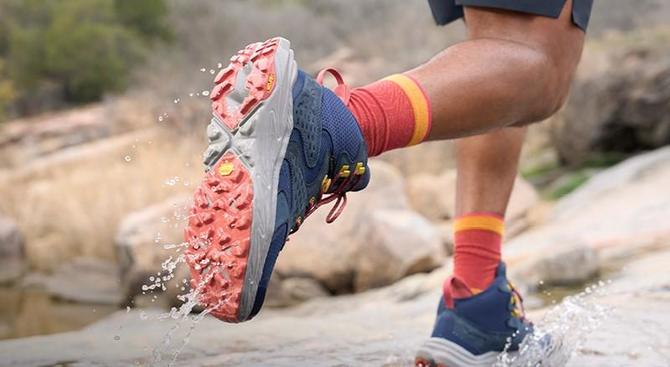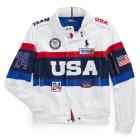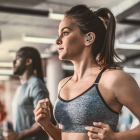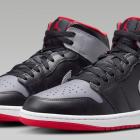
If you're new to hiking, prepare to become obsessed. Getting out on the trail is a chance to take a break from your normal routine and discover the beauty of nature. Plus, it counts as a workout and, depending on the trail, it can be a surprisingly intense one.
You don't need much to get started, but making sure you get best essentials is key to making your hiking adventure safe, comfortable and fun. There's nothing better than trekking out to a stunning waterfall -- and there's nothing worse than doing it in a pair of stiff, uncomfortable boots or a backpack that chafes and pinches at your shoulders.
To make sure you start your new hiking adventure on the right foot, we've put together a checklist of the best hiking essentials from our favorite boots to our favorite app for finding and planning your next outdoor adventure.
A comfortable pair of hiking boots: Hoka Anacapa 2

Finding a pair of hiking boots that feel comfortable and provide the right kind of support might be the most important thing to do in preparation for your first hike. When your feet hurt, it's hard to think about anything else except how much your feet hurt. It can also be dangerous to head out on gravely or muddy trails in shoes that weren't designed to handle that kind of terrain.
Our favorite hiking boot is the Hoka Anacapa 2 Mid. Already well-known for its ultra-comfortable running shoes and walking shoes, the brand's popular hiking boot received the American Podiatric Medical Association seal of acceptance as a comfortable, supportive boot.
The premium hiking boot features a lightweight EVA midsole, plush ankle collar and soft sock liner so your foot is completely enveloped in cloud-like comfort. A Gore-Tex liner and water-resistant leather upper protect your feet from the elements as you trek through mud, gravel and dirt.
Get the rugged yet cushy Hoka hiking boots for $195.
Shop men's sizes:
Shop women's sizes:
$195 at HokaA durable and lightweight backpack: Fjallraven S/F expandable hip back

When it comes to choosing a hiking backpack as a beginner, the key is to not overdo it. You don't need an oversized backpacking pack to head out on a two-mile hike. Remember that whatever you bring with you, you will be carrying from beginning to end.
That's why we recommend the Fjallraven S/F hip back. Ideal for short 1-2 hour hikes, you can wear it as a belt bag to stash your phone, keys, and water bottle. For a longer day hike, it expands into an 11.5-liter day pack with room enough to add a hearty lunch and extra water bottles alongside your other hiking essentials.
The expandable design is great for all kinds of day hikes, allowing you to be as unencumbered as possible while still being able to carry everything you need. Get the lightweight, expandable daypack at REI for $120.
$120 at REIA reusable water bottle: Hydro Flask

Staying hydrated is a top priority whenever you're exercising. But when you're out on a hike, it's more important than ever to make sure you're bringing enough water for the trek because you won't find many convenience stores out in the wilderness.
So make sure you grab a large-capacity yet lightweight water bottle like the Hydro Flask. With its flex straw lid, it's easy to sip while you walk and the double wall insulation will keep your water refreshingly ice cold for up to 24 hours.
We also like this water bottle for hikers because of the convenient carry handle on the lid. This gives you the option to either clip it to a backpack or carry it by the handle if it's hot day and you'll be taking frequent sips.
Get the 40-ounce size on Amazon for $50.
$50 at AmazonNon-slip sunglasses that you can afford to lose: Goodr OG

When you're heading outdoors, it's important to bring plenty of sun protection. That means sunscreen, a hat, and a pair of sunglasses. For the most part, there's not one right answer for any of these. Whatever hat, sunscreen and shades you already own will likely work just fine on a hike.
With that said, if your sunglasses are from a premium, expensive brand, we recommend leaving them at home. Not that you're planning to lose your sunglasses on the trail, but if you drop or break a $200 pair of shades, you will probably cry (at least, we sure would).
So we recommend wearing an affordable pair that do their sun-blocking job well but wouldn't sting as much if they accidentally got crushed at the bottom of your backpack.
These Goodr OG sunglasses fit the bill. They're lightweight and slip-resistant, so you can work up a sweat without them bouncing or sliding around your face. And as far as sun protection functionality, they're hard to beat with their polarized UV400 lenses that block out harmful UV rays and reduce glare.
Get them for $25 on Amazon or head directly to Goodr to shop their full collection of sport-specific sunnies.
$25 at Goodr $25 at AmazonAn app that makes planning for your hike easy: AllTrails

Every hike is different. A five-mile loop on mostly flat terrain will require different gear than a five-mile uphill climb to a peak. The type of terrain, the amount of shade cover along the way and other details can also dramatically influence what you should pack and how much.
The best way to get all those details about a trail you've never hiked before is the AllTrails app. If Yelp and Strava had a baby that was obsessed with the outdoors, that's AllTrails.
You can search for trails near you and see real reviews from other people who have hiked them. Alongside key data like mileage, elevation gain, overall difficulty rating, and a map of the trail route, those reviews give you first-person insights into how well the trail is maintained, when it's most or least crowded, the best season or time of day to hike it in, and more.
While the free version of the app gives you access to the trail maps and the ability to make lists, we highly recommend upgrading to AllTrails+. It's just $35.99 per year and unlocks important features like the ability to download maps for offline use, get real-time alerts if you stray from the path and live share your location with friends and families in case you get lost.
Sign up for a free trial of AllTrails+The 10 essentials of hiking that should be in your backpack
The American Hiking Society has a short and handy guide of the ten essentials of hiking. It includes the following:
- Comfortable footwear
- Water
- Sun protection, including a hat, sunglasses, and sunscreen
- A map (or GPS-enabled smartwatch or device)
- Food
- Rain gear and dry-fast layers
- Safety items, including a flashlight, whistle, and a way to start a fire
- A basic first aid kit
- A knife or multi-tool
- Shelter (which can be an emergency space blanket for short hikes)
We covered the first four in the roundup above, along with the backpack to stash it all in. For the rest of the items, what you pick will really depend on where you're going and how long your trek is. You can use the AllTrails app to help you figure out what kind of food and emergency gear make sense to bring with you.















